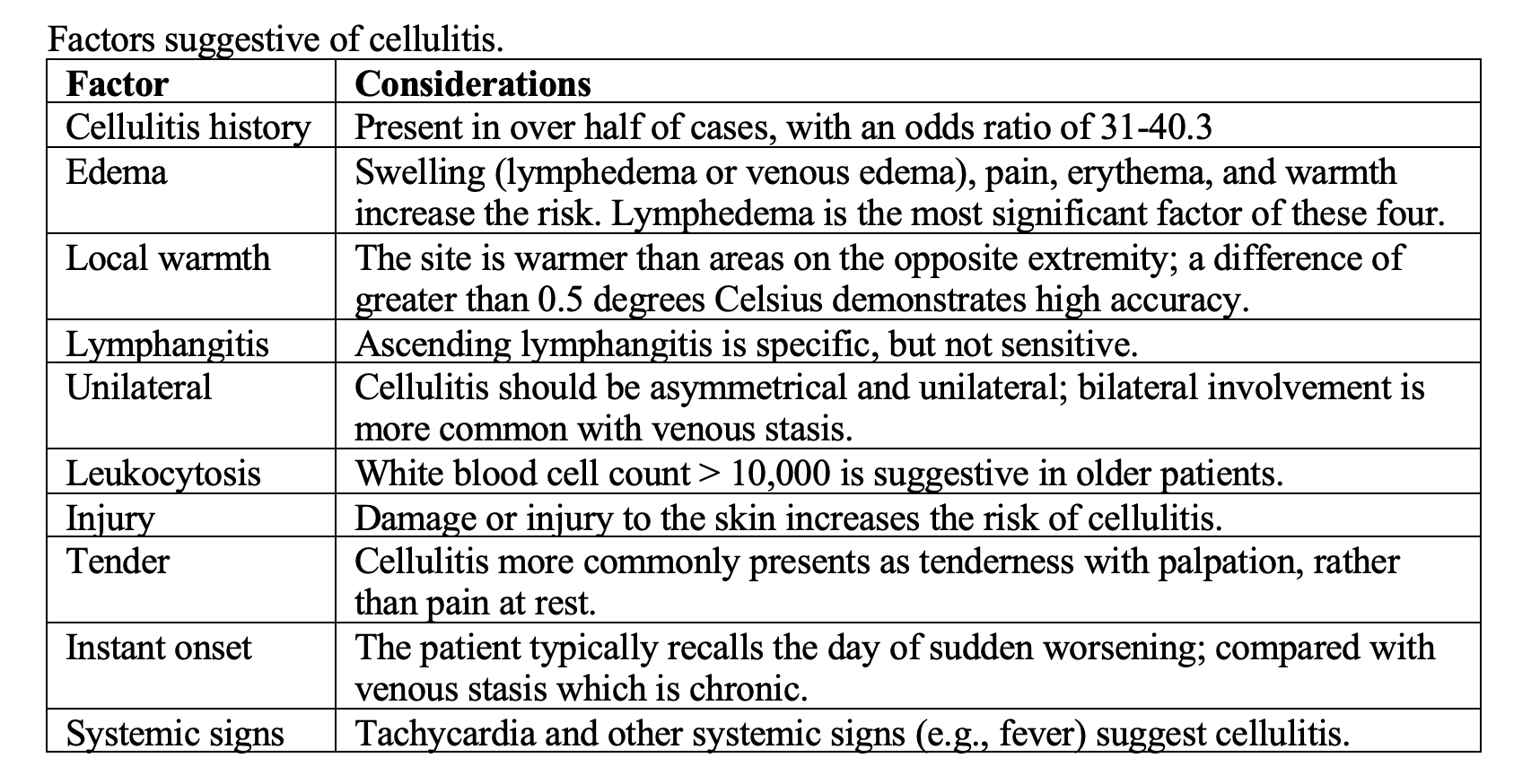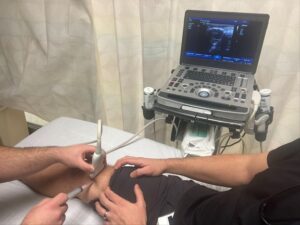Today on the emDOCs cast with Brit Long, MD (@long_brit), we cover cellulitis.
Episode 59: Cellulitis
Background:
- Cellulitis is one type of skin and soft tissue infection.
- Approximately 6 million patients visit an ED cellulitis or abscess.
- Cellulitis is more commonly seen in middle aged and older adults.
- The annual incidence of cellulitis ranges from 22 to 50 per 1,000 persons, with over 14 million cases in the United States every year.
- Around 10% require hospitalization.
- Risk factors: Edema secondary to impaired lymphatic drainage or venous insufficiency, obesity, skin inflammation (eczema, radiation therapy, psoriasis), skin trauma (abrasion/laceration, ulcers, bites, intravenous drug use), immunosuppression, and pre-existing skin conditions.
Pathophysiology:
- Cellulitis is an aute infection of the dermis and subcutaneous tissue caused by bacterial breach of the skin.
- Any disruption of the cutaneous barrier provides a site for normal skin flora and other bacteria to enter the dermis and subcutaneous layers of the skin, which can prompt an inflammatory response consisting of neutrophil recruitment and infiltration into the affected areas and cytokine production.
- Two bacteria are typically implicated in the infection: beta hemolytic streptococcus (over 70% of nonpurulent cellulitis cases) and Staphylococcus aureus (including methicillin resistant staph aureus; uncommon in cases of nonpurulent cellulitis).
- Streptococcus pneumoniae, Neisseria meningitidis, Clostridia (seen with crepitant and gangrenous cellulitis), and Haemophilus influenzae type b are less common causes of cellulitis but are more prevalent in those who are immunocompromised. Gram negative causes are not common.
History and Exam:
- Ask about the initial symptoms, including when they began, how they have progressed, any medications used or interventions performed, recent surgical procedures, and prior history of skin and soft tissue infections. History of diabetes, renal or liver disease, immunocompromising conditions, skin breaks, poor hygiene, obesity, edema, and venous insufficiency increase risk of cellulitis.
- Look carefully at the affected area, as well as the portal of entry for infection.
- Cellulitis most commonly presents as a unilateral rash with indistinct margins and local erythema, warmth, and swelling. The lower extremity is most commonly affected, and cellulitis may be circumferential.
- Lymphangitis, which occurs when the infection extends to the lymphatic system, will present as erythema overlying the lymphatic system extending towards lymph nodes.
- Purulence may or may not be present.
- Petechiae, vesicles, hemorrhage, and/or bullae can be present, but beware of necrotizing infections with these findings, especially with systemic symptoms.
- May be associated with systemic symptoms including fever, chills, lymphadenopathy, malaise, headache, nausea/vomiting.

Differential:
- A wide variety of conditions can present similarly.
- Data suggest previous cellulitis (odds ratio [OR]: 40.3), presence of a wound on the leg (OR: 19.1), current leg ulcer (OR: 13.7), lymphedema or chronic leg edema (OR: 6.8), excoriating skin disease (OR: 4.4), tinea pedis (OR: 3.2), and body mass index > 30 kg are ) are associated with increased risk of developing non-purulent cellulitis of the leg.
- One common differentiating factor is that cellulitis is typically acute and unilateral; involvement of both lower extremities usually suggests another condition. The redness of cellulitis typically does not improve with limb elevation.
- Pain out of proportion to examination, bullae, vesicles, and crepitus are suggestive of a necrotizing soft tissue infection, while erythema overlying a joint in a patient with painful range of motion and/or pain with axial loading suggests septic arthritis.
- Severe pain, significant edema, and skin discoloration of the entire extremity (e.g., white or blue) suggest phlegmasia alba dolens or cerulea dolens.



Complications:
- If left untreated, complications can include sepsis/bacteremia, endocarditis, septic arthritis or osteomyelitis, toxic shock syndrome, and necrotizing infection.
- There are multiple types of cellulitis aside from the commonly seen cellulitis on an extremity, with some having their own distinct complications.
- Abdominal wall cellulitis
- Buccal cellulitis (less common secondary to H. influenzae vaccine)
- Perianal cellulitis – anal scarring, fistula, or abscess
- Orbital cellulitis – septic cavernous thrombosis
Evaluation:
- Cellulitis is a clinical diagnosis; laboratory evaluation is nonspecific.
- CBC – leukocytosis may be present (34-50%)
- ESR/CRP – possible elevation (50-91%)
- Routine blood cultures are generally low yield and not recommended by the Infectious Diseases Society of America (IDSA).
- Blood cultures may be useful in patients with significant systemic symptoms who are at greater risk for atypical organisms (e.g., immunocompromise, exposure to aquatic injuries, animal bites) and those patients with concern for sepsis and bacteremia associated with soft tissue infection.
- The IDSA also does not recommend obtaining routine skin swabs of cellulitis or infected ulcers
- Radiographs have little role in evaluation of cellulitis.
- Ultrasound can be used as cobblestoning of the subcutaneous fat due to the inflammation may be visualized. Sensitivity is over 95%, with specificity over 85%.
- If there is concern for necrotizing fasciitis, utilize imaging modalities such as CT to obtain a diagnosis.

Management:
- Treatment includes antibiotics.
- Treatment groups divided into two groups: outpatient vs. inpatient (mg/kg is for pediatric dosing)
- Oral therapy
- Cover primarily for streptococcal species.
- Treatment is typically for 5 days but can be extended up to 10 days if warranted for slow response to treatment.
- The IDSA recommends most cases of non-purulent cellulitis be treated with penicillin VK, a cephalosporin, dicloxacillin, or clindamycin
- Cephalexin 500mg (6.25mg/kg) PO four times daily OR
- If penicillin allergic – Clindamycin 450mg PO three times daily
- Saltwater cellulitis – Cover for Vibrio with doxycycline or ciprofloxacin
- Freshwater cellulitis – Cover for Aeromonas with TMP/SMX, ceftriaxone, or ciprofloxacin
- Literature suggests the addition of TMP/SMX to cephalexin in patients with uncomplicated cellulitis does not improve clinical cure rates.
- MRSA should be suspected if there are systemic signs of toxicity (febrile, hypotensive, tachycardic), prior episode of MRSA infection, no improvement of the cellulitis while on an antibiotic regiment that does not currently include activity against MRSA, and/or there are one or more risk factors for MRSA (recent hospitalization, residence in long term care facility, recent surgery, hemodialysis, HIV infection, cellulitis over a joint that holds a prosthesis or overlying a vascular graft). If there is suspicion for MRSA, start:
- TMP/SMX (DS) 1-2 tablets (5 mg/kg) PO twice daily6OR
- Clindamycin 450 mg (10 mg/kg) PO three times daily
- Intravenous therapy
- Parenteral therapy should be utilized when not tolerating PO antibiotics, rapid progression of erythema, and/or progression of erythema 48 hours after starting PO antibiotics.
- Antibiotics
- Cefazolin 1-2 g (30 mg/kg) IV three times daily OR
- Clindamycin 600 mg (10 mg/kg) IV three times daily
- If MRSA is suspected (see outpatient MRSA guidelines), start:
- Daptomycin 4 mg/kg IV once daily OR
- Vancomycin 20 mg/kg IV twice daily7,8
- Oral therapy
- Pain control can be managed using NSAIDs as long as there are no contraindications (risk of bleeding, pregnancy, kidney disease). Literature suggests NSAIDs reduce the time to regression of inflammation and resolution of the cellulitis.
- Steroids should not be routinely given for cellulitis in the ED. Steroids show no decrease in percent relapse of cellulitis. More research is needed on whether outpatient steroids should be utilized.
Risks for treatment failure:
- Antibiotic failure can be defined as hospitalization, change in class of oral antibiotic, or switch to parenteral therapy, after 48 hours.
- Up to 30% of patients can have oral antibiotic failures.
- Indicators for failure of outpatient management include:
- Tachypnea at triage
- History of MRSA
- Cellulitis in the past 12 months
- Chronic ulcers
- Fever at triage
- Chronic edema or lymphedema
- Prior cellulitis in the same area
- Cellulitis at a wound site
Disposition:
- Most patients can be discharged.
- Discharge instructions
- Take the entire course of the prescribed antibiotic.
- NSAIDs and acetaminophen for pain relief.
- The infection may continue to worsen for up to 48 hours even while on antibiotics. If the infection continues to worsen past then, return to the ED.
- Discharge instructions
- Admit for the following:
- Outpatient treatment failure
- Significant comorbidity including immunocompromised state or poorly controlled diabetes
- Sepsis
- Significant hand, face, or genitalia infection
- Reason for parenteral therapy
Key Points:
- Cellulitis is a clinical diagnosis, but if there is concern for necrotizing fasciitis or other diagnoses, imaging modalities such as ultrasound or CT can be utilized.
- Start parenteral therapy when the patient is not tolerating PO antibiotics, there is rapid progression of erythema, and/or progression of erythema 48 hours after starting PO antibiotics.
- Admit the patient for sepsis, hand/face/genitalia cellulitis, or there is another reason for parenteral therapy (failed outpatient therapy).
From Dr. Katy Hanson at Hanson’s Anatomy:

Further Reading:
#FOAMed
References:
- Long B, Gottlieb M. Diagnosis and Management of Cellulitis and Abscess in the Emergency Department Setting: An Evidence-Based Review. J Emerg Med. 2022 Jan;62(1):16-27.
- Stevens DL, Bisno AL, Chambers HF, et al. Practice Guidelines for the Diagnosis and Management of Skin and Soft Tissue Infections: 2014 Update by the Infectious Diseases Society of America. Clinical Infectious Diseases. 2014;59(2):e10-e52.
- Brown BD, Hood Watson KL. Cellulitis. In: StatPearls. Treasure Island (FL): StatPearls Publishing; August 10, 2020.
- Cranendonk DR, Lavrijsen APM, Prins JM, Wiersinga WJ. Cellulitis: current insights into pathophysiology and clinical management. Neth J Med. 2017 Nov;75(9):366-378.
- Morris A. Cellulitis and erysipelas. Clin Evid. 2006;(15):2207-2211.
- Moran GJ, Krishnadasan A, Mower WR, et al. Effect of Cephalexin Plus Trimethoprim-Sulfamethoxazole vs Cephalexin Alone on Clinical Cure of Uncomplicated Cellulitis: A Randomized Clinical Trial. JAMA. 2017 May 23;317(20):2088-2096.








1 thought on “emDOCs Podcast – Episode 59: Cellulitis”
excellent